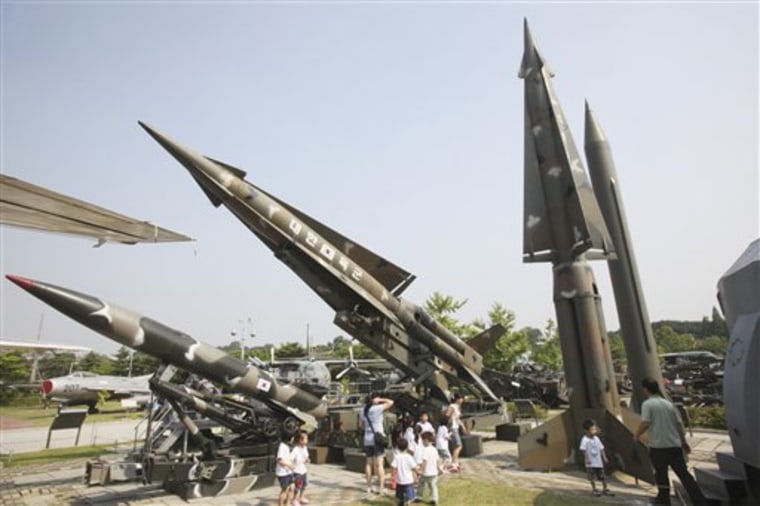North Korea's massive stockpile of chemical weapons is as threatening as its nuclear program, analysts said Thursday, highlighting an aspect of the secretive regime's pursuit of weapons of mass destruction that is rarely talked about.
Adding to already high tensions in the region, a Japanese report said North Korea may fire its most advanced ballistic missile toward Hawaii around Independence Day — the day when the regime test-fired a long-range missile three years ago, though it failed seconds after liftoff.
A new missile launch — though not expected to reach U.S. territory — would be a brazen slap in the face of the international community, which punished North Korea with new U.N. sanctions for conducting a second nuclear test on May 25 in defiance of a U.N. ban.
North Korea spurned the U.N. Security Council resolution with threats of war and pledges to expand its nuclear bomb-making program.
Meanwhile, U.S. officials said the military is tracking a ship from North Korea, the first vessel monitored under the new United Nations nonproliferation resolution.
Two officials say the Kang Nam is being monitored in the Pacific Ocean since it left North Korea on Wednesday. The officials say it is uncertain what the ship is carrying, though it believed to have been involved in weapons proliferation in the past.
They spoke on condition of anonymity to speak about intelligence.
The new U.N. resolution allows the international community to ask for permission to board any ships suspected of carrying weapons, nuclear material or missile parts. If no permission is granted the ship can be followed to its next port for inspection.
Range of up to 4,000 miles
The missile now being readied in the North is believed to be a Taepodong-2 with a range of up to 4,000 miles, and would be launched from North Korea's Dongchang-ni site on the northwestern coast sometime around July 4, Independence Day in U.S., the Yomiuri newspaper said.
It cited an analysis by Japan's Defense Ministry and intelligence gathered by U.S. reconnaissance satellites.
Pyongyang's missile and nuclear programs are centerpieces of the regime's catalog of weapons of mass destruction.
But the impoverished nation, which has put most of its scarce resources into boosting its military capabilities under its "army-first" policy, also has a large chemical arsenal, as well as capabilities to produce biological weapons.
On Thursday, an international security think tank warned that these weapons are no less serious a threat to the region than the North's nuclear arsenal.
The independent International Crisis Group said the North is believed to have between 2,500 and 5,000 tons of chemical weapons, including mustard gas, phosgene, blood agents and sarin. These weapons can be delivered with ballistic missiles and long-range artillery and are "sufficient to inflict massive civilian casualties on South Korea."
"If progress is made on rolling back Pyongyang's nuclear ambitions, there could be opportunities to construct a cooperative diplomatic solution for chemical weapons and the suspected biological weapons program," the think tank said in a report.
'Diplomacy is the least bad option'
It also called on the U.S. to engage the North in dialogue to defuse the nuclear crisis, saying "diplomacy is the least bad option." It said Washington should be prepared to send a high-level special envoy to Pyongyang to resolve the tension.
South Korea's annual defense report, published early this year, said that in addition to chemical weapons, the North is believed to be capable of producing biological weapons with agents like anthrax and smallpox.
But of immediate concern is Pyongyang's ballistic missile program, which would get a major boost if it is able to fire the Taepodong-2, which was last tested on July 4, 2006. That missile fell into the water about 40 seconds after takeoff.
Disregarding the setback, North Korea conducted its first-ever atomic test blast three months later.
While the Yomiuri speculated the latest Taepodong-2 could fly over Japan and toward Hawaii, it said the missile would not be able to hit Hawaii's main islands, which are about 4,500 miles (7,200 kilometers) from the Korean peninsula.
A spokesman for the Japanese Defense Ministry declined to comment on the report. South Korea's Defense Ministry and the National Intelligence Service — the country's main spy agency — said they could not confirm it.
Key players huddling this week
Key players in the nuclear standoff have been huddling with each other this week to discuss the crisis.
On Tuesday, President Barack Obama and South Korean President Lee Myung-bak met in Washington and agreed to build a regional and global "strategic alliance" to persuade North Korea to dismantle all its nuclear weapons.
In a rare move, leaders of Russia and China used their meetings in Moscow on Wednesday to urge the North to return to nuclear talks and expressed "serious concerns" about tension on the Korean peninsula.
The joint appeal appeared to be a signal that Moscow and Beijing are growing impatient with Pyongyang's stubbornness. Northeastern China and Russia's Far East both border North Korea, and Pyongyang's unpredictable actions have raised concern in both countries.
